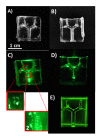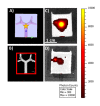Fabrication and Characterization of Optical Tissue Phantoms Containing Macrostructure
- PMID: 29553502
- PMCID: PMC5912403
- DOI: 10.3791/57031
Fabrication and Characterization of Optical Tissue Phantoms Containing Macrostructure
Abstract
The rapid development of new optical imaging techniques is dependent on the availability of low-cost, customizable, and easily reproducible standards. By replicating the imaging environment, costly animal experiments to validate a technique may be circumvented. Predicting and optimizing the performance of in vivo and ex vivo imaging techniques requires testing on samples that are optically similar to tissues of interest. Tissue-mimicking optical phantoms provide a standard for evaluation, characterization, or calibration of an optical system. Homogenous polymer optical tissue phantoms are widely used to mimic the optical properties of a specific tissue type within a narrow spectral range. Layered tissues, such as the epidermis and dermis, can be mimicked by simply stacking these homogenous slab phantoms. However, many in vivo imaging techniques are applied to more spatially complex tissue where three dimensional structures, such as blood vessels, airways, or tissue defects, can affect the performance of the imaging system. This protocol describes the fabrication of a tissue-mimicking phantom that incorporates three-dimensional structural complexity using material with optical properties of tissue. Look-up tables provide India ink and titanium dioxide recipes for optical absorption and scattering targets. Methods to characterize and tune the material optical properties are described. The phantom fabrication detailed in this article has an internal branching mock airway void; however, the technique can be broadly applied to other tissue or organ structures.
Similar articles
-
Three-dimensional fuse deposition modeling of tissue-simulating phantom for biomedical optical imaging.J Biomed Opt. 2015;20(12):121311. doi: 10.1117/1.JBO.20.12.121311. J Biomed Opt. 2015. PMID: 26603611
-
Fabrication of a multilayer tissue-mimicking phantom with tunable optical properties to simulate vascular oxygenation and perfusion for optical imaging technology.Appl Opt. 2018 Aug 10;57(23):6772-6780. doi: 10.1364/AO.57.006772. Appl Opt. 2018. PMID: 30129625
-
Fabrication and application of heterogeneous printed mouse phantoms for whole animal optical imaging.Appl Opt. 2016 Jan 10;55(2):280-7. doi: 10.1364/AO.55.000280. Appl Opt. 2016. PMID: 26835763 Free PMC article.
-
Review of tissue simulating phantoms for optical spectroscopy, imaging and dosimetry.J Biomed Opt. 2006 Jul-Aug;11(4):041102. doi: 10.1117/1.2335429. J Biomed Opt. 2006. PMID: 16965130 Review.
-
A review of tissue substitutes for ultrasound imaging.Ultrasound Med Biol. 2010 Jun;36(6):861-73. doi: 10.1016/j.ultrasmedbio.2010.02.012. Ultrasound Med Biol. 2010. PMID: 20510184 Review.
Cited by
-
Low-cost fabrication of optical tissue phantoms for use in biomedical imaging.Heliyon. 2020 Mar 21;6(3):e03602. doi: 10.1016/j.heliyon.2020.e03602. eCollection 2020 Mar. Heliyon. 2020. PMID: 32258463 Free PMC article.
-
Light scattering by pulmonary alveoli and airway surface liquid using a concentric sphere model.Opt Lett. 2018 Oct 15;43(20):5001-5004. doi: 10.1364/OL.43.005001. Opt Lett. 2018. PMID: 30320804 Free PMC article.
-
Optical model of the murine lung to optimize pulmonary illumination.J Biomed Opt. 2018 Mar;23(7):1-12. doi: 10.1117/1.JBO.23.7.071208. J Biomed Opt. 2018. PMID: 29573254 Free PMC article.
-
Depth-Resolved Attenuation Coefficient Quantification During Murine Embryonic Brain Development.J Biophotonics. 2025 Jun 23:e202500212. doi: 10.1002/jbio.202500212. Online ahead of print. J Biophotonics. 2025. PMID: 40551313
-
A Detailed Systematic Review on Retinal Image Segmentation Methods.J Digit Imaging. 2022 Oct;35(5):1250-1270. doi: 10.1007/s10278-022-00640-9. Epub 2022 May 4. J Digit Imaging. 2022. PMID: 35508746 Free PMC article.
References
-
- Curatolo A, Kennedy BF, Sampson DD. Structured three-dimensional optical phantom for optical coherence tomography. Opt Express. 2011;19(20):19480–19485. - PubMed
-
- Miranda DA, Cristiano KL, Gutiérrez JC. Breast phantom for mammary tissue characterization by near infrared spectroscopy. J Phys Conf Ser. 2013;466(1):012018.
-
- Wagnières G, et al. An optical phantom with tissue-like properties in the visible for use in PDT and fluorescence spectroscopy. Phys Med Biol. 1997;42(7):1415–1426. - PubMed
Publication types
MeSH terms
Substances
Grants and funding
LinkOut - more resources
Full Text Sources
Other Literature Sources








